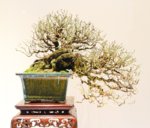Roses, love 'em or hate 'em. From photos I've gathered off the net over the years most do not fit ''classic'' bonsai definitions. They have been used off and on, even at Kokufu-ten.
Image by J White from 2013 Kokufu-ten.

Rose from Owen Reich's Blog, image by Owen Reich. My notes are a bit scrambled, when I scarfed this picture I thought is was a Rosa palustris collected from a swamp somewhere in Owen's home region, Kentucky or Tennessee. I did not dig back in Owen's Blog to see if my memory was correct. R. palustris is a North American native swamp rose with pink to white flowers that only blooms once a year.

Rosa wichuraiana image by Gazou, sometime before 2013

Posa polyantha posted on IBC June 2016 by Herbert A of Austria, image and tree by Herbert A.

Rosa 'Lady Banks' image by and owned by Steve Kudela from BNut April 2016

The above are all somewhat ''tree like'' and also show that wild slanting or cascading form is most common. I believe all the above bloom only once per year.
Now some that are more Kusamono like
Rose "Baby and Balls Penjing" by Nick Lenz, in the care of David Crust at the time of the photo. Image property of David Crust. I believe this is one of the repeat blooming modern miniature roses or a repeat blooming modern floribunda rose.

Rose by Greg Brendan, Brendan Studios, image scarfed from Brenden Studio's blog.

Rose Kusamono By Young Choe, image from Young Choe's blog 2017. Pot by Bill Stufflebeem

Rose shohin by Harushi

Rosa 'Ralph Moore' a repeat blooming miniature rose that is actually fragrant. Pre-bonsai, owned by me, not old enough to be called anything, eventually a kusamono.

So it is all over the map, some Rose examples I found have been long time cultivated plants of great age (the Kokufu-ten 2013 example), Some were old collected plants, like the Owen Reich's. Most have been garden raised, of varying ages but not of tremendous age. Most take quite a while to develop any sort of trunk. Grow out. prune back, grow out prune back, repeat.















